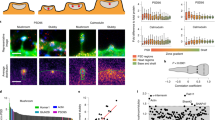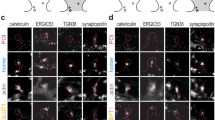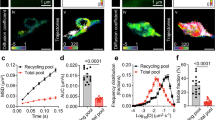Abstract
Postsynaptic membrane trafficking plays an important role in synaptic plasticity, but the organization of trafficking machinery within dendritic spines is poorly understood. We use immunocytochemical analysis of rat hippocampal neurons to show that proteins mediating endocytosis are systematically arrayed within dendritic spines, tangential to the synapse. Thus, previously unrecognized lateral domains of the spine organize endocytic protein machinery at sites removed from the postsynaptic density.
This is a preview of subscription content, access via your institution
Access options
Subscribe to this journal
Receive 12 print issues and online access
$209.00 per year
only $17.42 per issue
Buy this article
- Purchase on Springer Link
- Instant access to full article PDF
Prices may be subject to local taxes which are calculated during checkout


Similar content being viewed by others
References
Sheng, M. Proc. Natl. Acad. Sci. USA 98, 7058–7061 (2001).
Sorra, K.E. & Harris, K.M. Hippocampus 10, 501–511 (2000).
Segal, M. Prog. Brain. Res. 138, 53–59 (2002).
Carroll, R.C., Beattie, E.C., von Zastrow, M. & Malenka, R.C. Nat. Rev. Neurosci. 2, 315–324 (2001).
Mousavi, S.A., Malerod, L., Berg, T. & Kjeken, R. Biochem. J. 377, 1–16 (2004).
Conner, S.D. & Schmid, S.L. Nature 422, 37–44 (2003).
Blanpied, T.A., Scott, D.B. & Ehlers, M.D. Neuron 36, 435–449. (2002).
Petralia, R.S., Wang, Y.X. & Wenthold, R.J. Eur. J. Neurosci. 18, 3207–3217 (2003).
He, Y., Janssen, W.G., Rothstein, J.D. & Morrison, J.H. J. Comp. Neurol. 418, 255–269 (2000).
Baude, A. et al. Neuron 11, 771–787 (1993).
Valtschanoff, J.G. & Weinberg, R.J. J. Neurosci. 21, 1211–1217 (2001).
Toni, N. et al. J. Neurosci. 21, 6245–6251 (2001).
Ashby, M.C. et al. J. Neurosci. 24, 5172–5176 (2004).
Choquet, D. & Triller, A. Nat. Rev. Neurosci. 4, 251–265 (2003).
Takumi, Y., Ramirez-Leon, V., Laake, P., Rinvik, E. & Ottersen, O.P. Nat. Neurosci. 2, 618–624 (1999).
Acknowledgements
We thank I. Perez-Otano and M. Pucak for comments on the text and H. Zhang, I. Lebedeva and K. Phend for technical support. Supported by the National Alliance for Research on Schizophrenia and Depression (T.A.B.), Christopher Reeve Paralysis Foundation (M.D.E.), Broad Foundation Scholar Award (M.D.E.) and US National Institutes of Health (M.D.E., R.J.W.).
Author information
Authors and Affiliations
Corresponding author
Ethics declarations
Competing interests
The authors declare no competing financial interests.
Supplementary information
Supplementary Fig. 1
Coated pits in postsynaptic regions of cultured hippocampal neurons. (a) Coated pits (arrowheads) in spines and dendrites of cultured hippocampal neurons, as revealed by EM. Note that coated pits typically lie away from the PSD. (b) Confocal image of a cultured hippocampal neuron co-transfected with clathrin-DsRed and PSD-95-GFP. PSD-95 often clustered into puncta at presumptive excitatory synapses (arrowheads); in these regions, clathrin puncta were also prevalent. Stretches of dendrite without PSD-95 puncta (brackets) usually lacked clathrin puncta. (c) Linescan analysis of the image in (b), showing mean intensity along an 8 pixel-wide line traced along the center of the dendrite. (JPG 264 kb)
Supplementary Fig. 2
AP-2 and dynamin colocalize with clathrin in dendritic spines. (a) Projected confocal z-stack of a dendrite from a 28 DIV cultured hippocampal neuron co-transfected with the AP-2 subunit β2-adaptin-YFP (green) and clathrin-CFP (red). β2-adaptin colocalized with clathrin puncta throughout the dendrite and in spines (arrowheads) and also displayed diffuse cytosolic fluorescence outside of the clathrin-positive puncta. The magnified region (bottom panels) shows a single spine extending upwards from a dendritic shaft, highlighting the precise colocalization of clathrin and β2-adaptin in the spine head (arrow). The thin spine neck is barely visible. (b) A pair of dendrites from a 28 DIV neuron co-transfected for 36 hrs with dynamin 2-GFP (green), clathrin-DsRed (red), and PSD-95-CFP (not shown). Dynamin localized strongly to clathrin puncta (arrowheads). High magnification view shown in lower panels. Arrows point to double-labeled spine heads. Scale bar: 5 μm upper panels; 1 μm lower panels. (JPG 85 kb)
Supplementary Fig. 3
Double labeling immuno-EM for endocytic proteins. Immunoperoxidase staining for one antigen combined with pre-embedding immunogold labeling for another show endocytic proteins co-expressed in dendritic spines: (a,b) clathrin (immunogold, arrowheads) and AP-2 (electron-dense immunoperoxidase precipitate). (c) dynamin (immunoperoxidase) and AP-2 (immunogold, arrowhead). Scale bar: 200 nm (JPG 91 kb)
Rights and permissions
About this article
Cite this article
Rácz, B., Blanpied, T., Ehlers, M. et al. Lateral organization of endocytic machinery in dendritic spines. Nat Neurosci 7, 917–918 (2004). https://doi.org/10.1038/nn1303
Received:
Accepted:
Published:
Issue Date:
DOI: https://doi.org/10.1038/nn1303
This article is cited by
-
Arc weakens synapses by dispersing AMPA receptors from postsynaptic density via modulating PSD phase separation
Cell Research (2022)
-
Distribution of cortactin in cerebellar Purkinje cell spines
Scientific Reports (2021)
-
Stimulation-induced differential redistributions of clathrin and clathrin-coated vesicles in axons compared to soma/dendrites
Molecular Brain (2020)
-
Setting the stage for a role of the postsynaptic proteome in inherited neurometabolic disorders
Journal of Inherited Metabolic Disease (2018)
-
Bidirectional regulation of synaptic transmission by BRAG1/IQSEC2 and its requirement in long-term depression
Nature Communications (2016)



